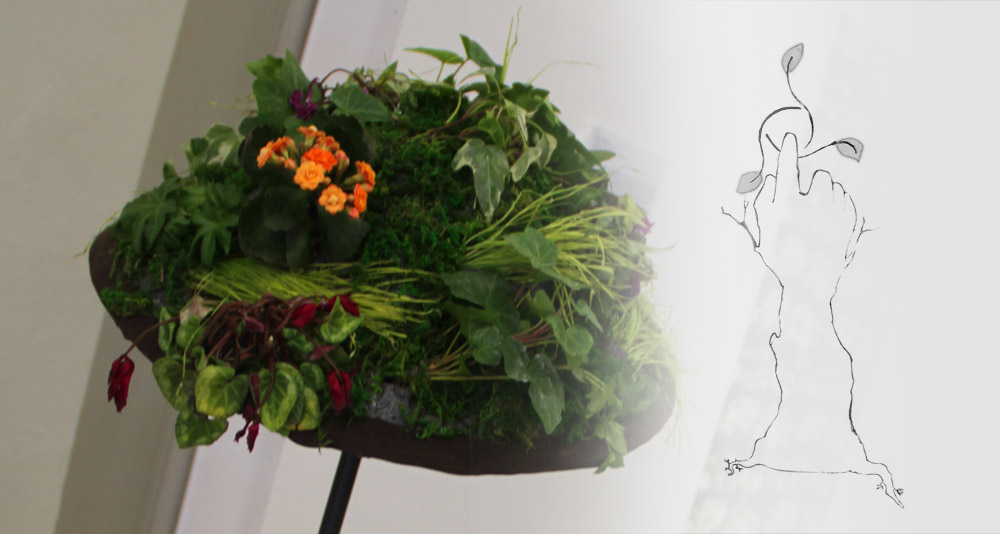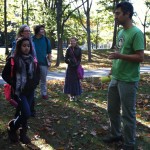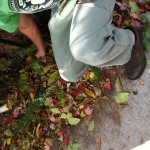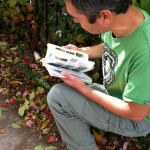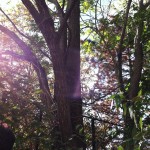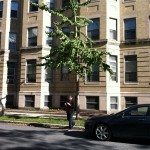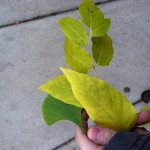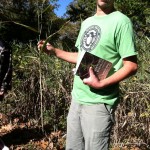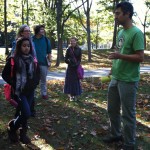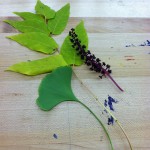Category Archives: Uncategorized
student groups
Did you know there are five (FIVE) student groups on campus working around issues of sustainability?
ReStore
Green Hands
Garden Collective
Sustainability Initiative
Outdoor Club
weeds and the fens
 On Tuesday, October 16th, Dr. Nathan Phillips led a group of MassArt students and faculty on “A Tour of the Weeds of the Fenway.” As a student involved in sustainability efforts on campus, I was very excited to learn about local plant life and their uses.
On Tuesday, October 16th, Dr. Nathan Phillips led a group of MassArt students and faculty on “A Tour of the Weeds of the Fenway.” As a student involved in sustainability efforts on campus, I was very excited to learn about local plant life and their uses.
We began by looking at a low-growing, leafy plant known as garlic mustard. Garlic mustard began to gain notice in the 1980s, when it spread rapidly through the Northeast after having existed there far less prodigiously for many years prior. An edible plant, it remains green in the winter when similar sources like lettuce and spinach are dead or have not yet leafed, and is thus a very useful species. It also does very well in urban areas due to high nitrogen, nitric acid, and carbon dioxide levels.
We went on to identify Alanthis altisima (“Tree of Heaven”), Ginkgo, Phragmiti australis (“Common Reed”), and Japanese Knotweed, among other species.
Though some of the plants we studied are edible, Dr. Phillips stressed that one should never forage for food in an urban or suburban environment without first testing the soil for lead and other toxins. These toxins can be picked up by the plant and transferred to the human body. However, we can still learn much from these plant species and their current place within our social structures.
Throughout the tour, the group discussed questions such as:
What is a weed?
What is an invasive species?
Do “invasive” plants displace existing plant species, or do they occupy niches that other plants can’t?
Can humans develop relationships with so-called invasive and pest species, such as kudzu and the Eastern Coyote, to help solve climate issues?
We ended the tour with some tasty, homemade pesto – made from garlic mustard from Dr. Phillip’s yard (soil tested!).
Overall, I found the tour to be a fun and informative introduction to both the plant life of Boston and to co-habitation possibilities between humans and the plants we often dismiss as “weeds.”
posted by Amelia Young, 3D senior
All photos courtesy of Tess Lukey
Lecture: READING THE URBAN LANDSCAPE
Lecture by MassArt’s Scientist-in-Residence: Nathan Phillips
Tomorrow night at 7pm in Pozen Center!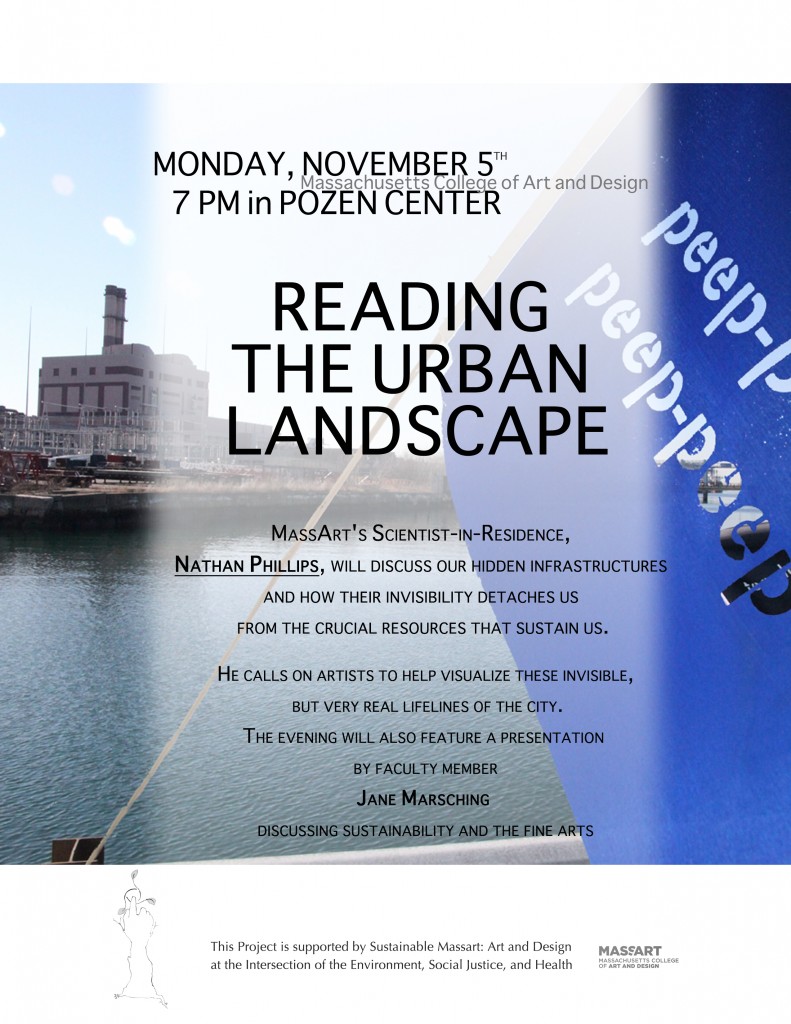
MassArt’s Scientist-in-Residence, Nathan Phillips, will discuss our hidden infrastructures and how their invisibility detaches us from the crucial resources that sustain us. He calls on artists to help visualize these invisible, but very real lifelines of the city.
The evening will also feature presentations by MassArt Faculty Jane Marsching on the fine arts and sustainability
A Sustainable Massart Initiative event
CALL FOR ART
Form to fill out- Sustain/Able Exhibition
This Fall, MassArt hosts its first-ever Scientist in Residence!
Nathan Phillips is a professor at Boston University whose research focuses on the relationships between plant physiology, ecosystems, and climate change.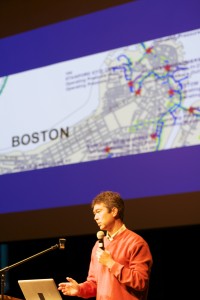
ENGAGEMENT
As part of his residency, Nathan will be visiting several MassArt classes to introduce his research, talk to students about their projects, offer his perspective as a scientist, and experiment with developing a hybrid art/science practice.
EVENTS
In addition to class visits, Nathan will be available during weekly Open Studio Office Hours every Wednesday from 1-3pm in South 308 lab studio. Students can stop by to discuss scientific and artistic issues, receive feedback on current work, brainstorm art-science projects, and coordinate collaborative projects with both Nathan and members of the wider MassArt community.
On Tuesday, October 16th at 2pm, Nathan will lead “A Tour of the Weeds of the Fenway” with the specific goal of taking a look at the invasive species, and considering their impacts– possibly positive as well as negative. Meet in South 308 at 2pm; the field trip will take about an hour.
On November 5th, Nathan will present a talk entitled “Reading the Urban Landscape”, where he will discuss our hidden infrastructures and how their invisibility detaches us from the crucial resources that sustain us. He calls on artists to help us visualize the invisible but very real and crucial lifelines of the city.
EXHIBITION
Additionally, from December 3rd-7th the exhibition Sustain/Able will be up in the North Crackatorium at MassArt. The Opening Reception will take place Thursday, Dec. 6th from 6:30-8pm. This exhibition will include work that addresses visionary approaches to sustainability across multiple MassArt departments and organizations.
Spearheaded by the Sustainable Massart Initiative as well as new and ongoing student groups, the exhibition will be an interdisciplinary romp through student, faculty, and visiting scientist’s visions of a sustainable world and future. Works will deal with the perception and quantification of the natural world, interrogate sustainable materials, investigate sustainability as process, and explore the complex relationships human beings maintain with their changing natural environment. We are currently accepting proposals for this exhibition. All proposals must be received by October 22nd. Those selected to participate will be notified by November 2nd.
GOALS
The goal of this Scientist-in-Residency program is to find productive ways that scientists and artists can exchange information, ideas, methods of investigation and presentation, unearth new ways of interpreting ideas, and create unique art-science syntheses.
Scientists utilize processes of exploration, revealing, refinement, and development in their research—artists utilize similar processes. By inviting a scientist to develop his own artistic practice we hope that Nathan will gain insight into alternative processes of investigation and will be able to help students interrogate and structure their own creative process in novel and unprecedented ways.
